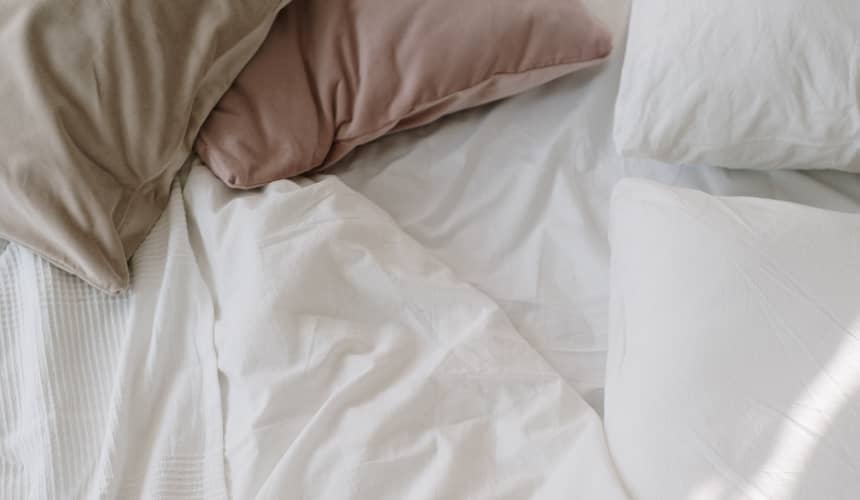Sorting and Preparation for Washing Bed Linen
Before starting the actual cleaning and washing process, it is important to sort your bed linen in the most appropriate way. Separate white, colored, and dark duvets, sheets, and pillowcases. This will prevent the risk of color mixing and bleeding. Bedding for small children and adults should be washed separately, as delicate fabrics for children are treated with skin-friendly detergents that prevent allergies. It is advisable to pre-treat any dried stains and dirt using a suitable special detergent or a mixture of water and gentle washing agent.
Choosing the Right Detergent
When it comes to choosing a detergent, we recommend selecting a mild, non-aggressive, non-bleaching, and eco-friendly product. Detergents with aggressive cleaning formulas and strong active ingredients can reduce fiber strength, damage the integrity of your bed linen fabrics, and cause color fading. Hypoallergenic detergents without fragrances are the perfect solution for both children and people with sensitive skin or allergies. Avoid using fabric softeners, as they often do not fully absorb, resulting in residual stains on the fabric.
Instructions for Machine Washing Bed Linen
To ensure optimal cleaning quality and long-lasting use of your duvets, follow these basic washing machine guidelines:
- Choose the correct spin speed: Do not set higher spin speeds than those recommended for the specific fabric. Keep in mind that the optimal spin speed for delicate fabrics is 600 to 800 rpm. Do not exceed this to minimize premature wear and tearing of the fabrics.
- Select an appropriate water temperature for optimal cleaning: Follow the care instructions of your bed linen to determine the suitable temperature. Generally, avoid using water that is too cold or too hot, as low temperatures will not effectively remove bacteria, and high temperatures can cause fabric wear and reduce color brightness. Washing at no less than 70°C is recommended.
- Consider the load capacity: Avoid overloading the washing machine to allow proper distribution of detergent for thorough washing, cleaning, and rinsing.
- Avoid mixing materials: Washing bed linen separately from other clothes is mandatory. This reduces the risk of reduced washing quality and fabric damage.

Drying Bed Linen
Besides proper cleaning, correct drying techniques also play an important role in maintaining the quality of your bed linen. Here are some useful tips for proper drying:
- Drying outdoors: Whenever possible, dry your linen outside, as this is the most natural and gentle drying method. Hang duvets on a clothesline outdoors or use a dryer.
- Drying in a dryer: If you use a dryer, choose a low or medium temperature to prevent excessive shrinking or damage to delicate fabrics. Remove the laundry immediately after drying to minimize further wrinkling and creasing.
- Avoid direct sunlight: Prolonged exposure to direct sunlight can cause colors to fade, so we recommend drying in shaded areas.
Guidelines for Proper Ironing
Proper ironing of bed linen not only removes wrinkles but also ensures a clean and welcoming appearance of your duvets and pillowcases. Follow these tips for effective ironing:
- Follow fabric care instructions: Check the care label for the appropriate ironing temperature. Different fabrics require different temperature settings.
- Iron while slightly damp: Ironing fabrics while slightly damp reduces the need for higher temperature and helps achieve better results.
- Use steam: To prevent direct contact between the iron and delicate fabrics, use a cloth or the steam function.
Storage Practices
Proper storage ensures your bed linen remains clean and well-preserved when not in use. Consider applying the following practices:
- Store clean, ventilated, and dry: Before storing, ensure your duvets are thoroughly cleaned and completely dry to prevent mold or mildew. Store in a cool, dry place such as a linen cupboard or appropriate storage box.
- Avoid plastic bags: Instead of plastic bags, use breathable fabric bags or textile covers with zippers to allow air circulation and prevent unpleasant odors.
- Rotate your bed linen: To prevent excessive wear and tear on a single set of bed linen, rotate your sets regularly, ideally changing them at least once a week.
By applying these best practices for cleaning, maintenance, and storage of bed linen, you can extend its lifespan and enjoy fresh and comfortable sleep. At TED, you will find bedroom sets of exceptional quality and durability, ensuring the comfort and peace of your night's rest.









